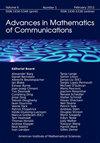A proof of the conjectured run time of the Hafner-McCurley class group algorithm
IF 0.7
4区 计算机科学
Q3 COMPUTER SCIENCE, THEORY & METHODS
引用次数: 1
Abstract
We present a proof under a generalization of the Riemann Hypothesis that the class group algorithm of Hafner and McCurley runs in expected time
Hafner-McCurley类群算法的推测运行时间证明
We present a proof under a generalization of the Riemann Hypothesis that the class group algorithm of Hafner and McCurley runs in expected time \begin{document}$ e^{\left(3/\sqrt{8}+o(1)\right)\sqrt{\log d\log\log d}} $\end{document} where \begin{document}$ -d $\end{document} is the discriminant of the input imaginary quadratic order. In the original paper, an expected run time of \begin{document}$ e^{\left(\sqrt{2}+o(1)\right)\sqrt{\log d\log\log d}} $\end{document} was proven, and better bounds were conjectured. To achieve a proven result, we rely on a mild modification of the original algorithm, and on recent results on the properties of the Cayley graph of the ideal class group.
本文章由计算机程序翻译,如有差异,请以英文原文为准。
求助全文
约1分钟内获得全文
求助全文
来源期刊

Advances in Mathematics of Communications
工程技术-计算机:理论方法
CiteScore
2.20
自引率
22.20%
发文量
78
审稿时长
>12 weeks
期刊介绍:
Advances in Mathematics of Communications (AMC) publishes original research papers of the highest quality in all areas of mathematics and computer science which are relevant to applications in communications technology. For this reason, submissions from many areas of mathematics are invited, provided these show a high level of originality, new techniques, an innovative approach, novel methodologies, or otherwise a high level of depth and sophistication. Any work that does not conform to these standards will be rejected.
Areas covered include coding theory, cryptology, combinatorics, finite geometry, algebra and number theory, but are not restricted to these. This journal also aims to cover the algorithmic and computational aspects of these disciplines. Hence, all mathematics and computer science contributions of appropriate depth and relevance to the above mentioned applications in communications technology are welcome.
More detailed indication of the journal''s scope is given by the subject interests of the members of the board of editors.
 求助内容:
求助内容: 应助结果提醒方式:
应助结果提醒方式:


